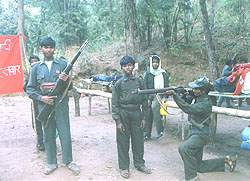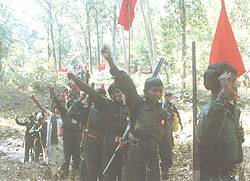The
killing of 55 policemen in Bijapur districts in Chhatisgarh
is the biggest attack on the system by any extremist
group in the country since the Sikh terrorism of 1980s.
Even during the 16 years of militancy in Jammu and Kashmir
not so many men in uniform lost their lives in one go.
It was during the storming of the Golden Temple in Amritsar
on June 4, 1984 that much larger number of army and
police personnel were killed at the hands of the terrorists
led by Sant Jarnail Singh Bhindranwala. The army and
the para-military forces were completely taken back
by the fire-power and preparation of the terrorists
ensconced within and they had to seek the help of tanks,
mortars and machine guns in the battle which
lasted for about 48 hours.
However,
since then never before so many policemen lost their
lives in any operation anywhere in the country. In Chhatisgarh
the policemen did not lose their lives while carrying
out any operation but became the soft target of the
massive Maoist onslaught.
 In
the last few months more policemen have been killed
in this central Indian state than even in the trouble-torn
Jammu and Kashmir and North-East. Till 2005 Jharkhand
was second in losing the number of policemen. Jammu
and Kashmir was obviously number one.
Andhra Pradesh was another state where a large number
of policemen were being targeted. Orissa, Madhya Pradesh
and Maharashtra also witnessed some incidents
In
the last few months more policemen have been killed
in this central Indian state than even in the trouble-torn
Jammu and Kashmir and North-East. Till 2005 Jharkhand
was second in losing the number of policemen. Jammu
and Kashmir was obviously number one.
Andhra Pradesh was another state where a large number
of policemen were being targeted. Orissa, Madhya Pradesh
and Maharashtra also witnessed some incidents
of violence in the recent years. In Orissa about 2,000
rifles were looted from police in one such attack. Chhatisgarh
has now left all of them behind. The centrality of the
state is an important factor. It is almost at the Centre
of the Red Corridor, right from Nepal to the southern
tip of Andhra Pradesh. Besides, the topography suits
the extremists. Notwithstanding industrialization poverty
is rampant, especially in the rural areas.
One
needs to understand the difference between the extremist
movements in the plains and in the hills and jungles
of the country. While in the states like Bihar the ultra-Left
movement has been locked more against the landed upper
castes––and now even against some backward
castes kulaks––in Jharkhand and Chhatisgarh
the state machinery is being targeted more blatantly
now. It is not that in Bihar the attack has not been
made on the police stations or jails. The last big Naxal
operation took place on November 13, 2005. About 1,000
ultras set on the very nerve centre of power in Jehanabad
district and after killing a number of policemen broke
the jail and took away their men. More than 90 of these
inmates are still at large and the police are still
groping in the dark. However, one of the leading light
of the Maoists in the country, Ajay Kannu––who
fled from that infamous Jehanabad jail break––was
rearrested from a train in Kolkata recently.
But
Bihar shot into fame in 1970s and more forcefully in
1980s and 1990s for the massacres of Dalits and Backward
Castes. The private armies of the upper caste farmers
used to target them on the plea that they are the supporters
of the Left ultras or are soft towards them. Ranveer
Sena was only the last and most formidable link in the
same chain of private armies. In the same way the Maoists
indulged in the massacres of the upper castes, especially
Bhumihar and /Rajput farmers of what was then called
the central––but now south––Bihar.
 Even
in the undivided Bihar the pattern of Left violence
was different in the southern plateau which after November
15, 2000 came to be known as Jharkhand. There too the
struggle was initially against the landed farmers, but
the extremists gradually shifted their strategy. They
started targeting the power centres more brazenly than
elsewhere in Bihar. By now they virtually decimated
their opponents in the rural areas. The hills and forests
of the then South Bihar and now Jharkhand became the
happy hunting ground for the ultras’ hideout. The
abundance of mines paved the way for a different kind
of violence. Dynamites were easily available in Jharkhand.
Therefore, landmine blasts are very common. Now the
same tactic is being adopted in the mineral-rich Chhatisgarh.
The pattern of Naxal violence in Jharkhand and Chhatisgarh
is almost similar.
Even
in the undivided Bihar the pattern of Left violence
was different in the southern plateau which after November
15, 2000 came to be known as Jharkhand. There too the
struggle was initially against the landed farmers, but
the extremists gradually shifted their strategy. They
started targeting the power centres more brazenly than
elsewhere in Bihar. By now they virtually decimated
their opponents in the rural areas. The hills and forests
of the then South Bihar and now Jharkhand became the
happy hunting ground for the ultras’ hideout. The
abundance of mines paved the way for a different kind
of violence. Dynamites were easily available in Jharkhand.
Therefore, landmine blasts are very common. Now the
same tactic is being adopted in the mineral-rich Chhatisgarh.
The pattern of Naxal violence in Jharkhand and Chhatisgarh
is almost similar.
It
is not that in Chhatisgarh or Jharkhand the landed and
relatively affluent farmers did not oppose the naxals.
Jawala Singh of Manatu in Palamu district of Jharkhand
was a known name of the yesteryears. Jawala, if the
reports are true, used to have a maneater tiger as his
pet and he used to terrify the people with its help.
In Jharkhand region too there used to be the private
army, Sunlight Sena. Earlier it was led by Rajputs.
A close kin of former governor of Tamil Nadu, Bhishm
Narain Singh, also lost his life in that tussle between
the Naxals and their opponents. Singh was originally
from old Palamu district. In the late 1980s and early
1990s some Pathans too joined this outfit.
However,
the biggest attack on the police machinery in Jharkhand
came during the first phase of 1999 Lok Sabha election
on September 19, 1999. Thirty seven policemen and two
magistrates lost their lives in three land mine blasts
in Hazaribagh and Chatra districts. Then it was a part
of Bihar. But after the creation of Jharkhand the naxals
took the state by storm. In the first five years of
its creation as many as 250 policemen––including
senior officials––lost their lives in some
daring operations by the naxals. In many of them land
mines were used.
It
needs to be mentioned that during the elections police
and security personnel were made the target of the Naxals.
Since there is a large amount of movement of police
into the interiors of the hills and jungles the Maoists
utilize the opportunity for their own end. They trigger
landmine blasts to kill the policemen and subsequently
loot their arms and ammunition. As in September 1999
election eve attack the Maoixts struck again on April
6-7, 2004 in Jharkhand. More than two dozens policemen
were killed in land mine blasts in that state. The attack
coincided with the visit of the then deputy Prime Minister,
Lal Krishna Advani, to Jharkhand. He was leading an
election eve yatra of the country. The November 13,
2005 attack on Jehanabad jail also took place about
60 hours before the last phase of assembly election
in Bihar.
But
not all the attacks have been carried during the election
period. The March 15 incident in Chhatisgarh is one
such example. Like in Bihar or Jharkhand a sort of private
army came up to fight the Maoists. It is known as Salwa
Judum. If men in uniform have become lame ducks before
the Naxals the Salwa Judum stands no
chance to check their onslaught.
comment